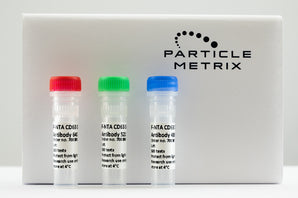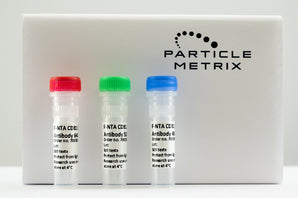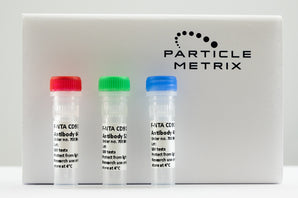Authors
Melanie Reininger*, Claudia Lindner*, Dr. Ingrid Hartl*, Dr. Christina Klasen**, Dr. Roland Prielhofer* and Dr. Klaus Graumann*
A collaboration of

Introduction
Downstream process monitoring for extracellular vesicles (EVs) with respect to particle quantification has proven difficult. These problems may arise from shear forces affecting particle stability, unoptimized formulations and above all, the presence of media-derived aggregates from complex components such as serum or human platelet lysate (hPL).
By using serum- and hPL-free cultivation media and gentle purification methods, Phoenestra is able to display particle mass balances and calculate realistic yields for mesenchymal stromal cell (MSC)- derived EV processes. In collaboration with Particle Metrix a relative increase of tetraspanin-positive particles in the course of downstream processing can be shown.
Methods
The supernatant from MSC/TERT cultivation is continuously harvested in perfusion mode using EVscale™ technology. Conditioned medium is stored at -80°C until further processing. To remove precipitates, a gentle depth filtration step with a 2–4 µm cutoff is performed. For improved recovery, the filter is flushed with buffer leading to a concentration factor (CF) of 0.8. This is followed by tangential-flow filtration (TFF) using a low- shear membrane pump and a hollow-fiber module with a 300 kDa molecular weight cutoff (MWCO). During this step, the conditioned medium is concentrated and buffer exchanged with six diavolumes, achieving an exchange rate of >98% and a CF of 3-4. To further increase the particle concentration, an additional spin filtration step (MWCO: 100 kDa) is applied reaching CFs of ~ 50. Before aliquoting, a final centrifugation step removes large aggregates and precipitates formed during processing. Samples are taken before and after each unit operation and analyzed via Nanoparticle Tracking Analysis (ZetaView®, Particle Metrix). Light scattering mode (NTA) is used to quantify total particle numbers, while fluorescent mode (F-NTA), combined with prior F-NTA Tetraspanin Detection Kit labeling, quantifies CD9, CD63, and CD81 expressing vesicles.



Figure 1: NTA measurement and Process Yield: Two independant downstream processes with different starting material (different cell source, different cultivation) are performed and analyzed. The Particle Yields of the different unit operations are shown: depth filtration: ~ 90 %; TFF ~80 %; final concentration: 65-85 %. This results in an overall process Yield of 50 – 60 %.
Figure 2: F-NTA measurement - Tetraspanin-positive Particle Concentration: An enrichment in tetraspanin-positive particles in the course of downstream processing is shown.
Figure 3: Tetraspanin-positive particles (F-NTA) in % of all detected particles (NTA): The relative amount of tetraspanin-positive particles, hence EVs, is increasing in the course of downstream processing. This suggests that non-EV particles are successfully depleted.
Summary
- Nanoparticle Tracking Analysis (NTA) can be reliably used for particle mass balancing when applied in the right context, such as in human platelet lysate (hPL)- and serum-free media, combined with gentle processing conditions.
- Fluorescent labeling using the F-NTA Tetraspanin Detection Kit can confirm the specificity of the extracellular vesicle (EV) enrichment method.
*Phoenestra GmbH
**Particle Metrix GmbH
Contact address Phoenestra:
Phoenestra GmbH, Huemerstraße 3-5, 4020 Linz, Austria, office@evscale.info
Disclaimer: While we have taken every care to ensure that the information in this document is correct, nothing herein should be construed as implying any representation or warranty as to its accuracy, correctness or completeness of this information and we shall not be held liable for any errors therein or for any damages in connection with the use of this material. Particle Metrix reserves the right to change the content of this material at any time without notice.
Copyright: © March 2025 Particle Metrix. This publication or parts thereof may not be copied or distributed without our express written permission.





